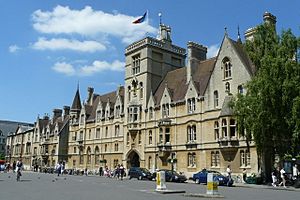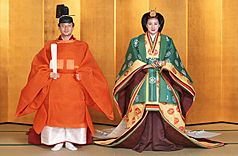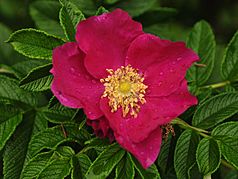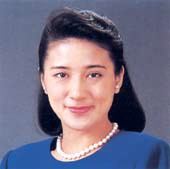Empress Masako facts for kids
Quick facts for kids Masako
|
|
|---|---|
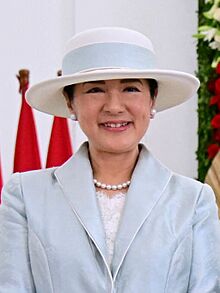
Masako in 2023
|
|
| Empress consort of Japan | |
| Tenure | 1 May 2019 – present |
| Enthronement | 22 October 2019 |
| Born | Masako Owada (小和田雅子) 9 December 1963 Toranomon Hospital, Toranomon, Minato, Tokyo, Japan |
| Spouse | |
| Issue | Aiko, Princess Toshi |
| House | Imperial House of Japan |
| Father | Hisashi Owada |
| Mother | Yumiko Egashira |
| Signature |  |
Masako (born Masako Owada; December 9, 1963) is the current Empress of Japan. She is married to Emperor Naruhito.
Masako was born in Tokyo, Japan. She went to Belmont High School in Massachusetts, USA. Later, she attended Harvard College, where she earned a degree in economics. She also studied law at the University of Tokyo and international relations at Balliol College, Oxford. Before becoming a royal, she worked as a diplomat for Japan's Ministry of Foreign Affairs.
Masako met Naruhito in 1986. They got married in 1993. Their only child, Aiko, Princess Toshi, was born in 2001. After Aiko's birth, there was a discussion about changing the rules for who can become emperor or empress in Japan. Currently, only males can inherit the throne. However, when Naruhito's brother, Prince Fumihito, had a son in 2006, the rules were not changed. This means Aiko cannot become empress after her father.
The pressure to have a male heir affected Masako's health. In 2004, she was diagnosed with an adjustment disorder. This meant she sometimes had to take time away from public duties. As crown princess and later empress, Masako has traveled with her husband to other countries. She also attends important ceremonies in Japan.
Contents
Masako's Early Life and Schooling
Masako Owada was born on December 9, 1963, in Tokyo. Her mother is Yumiko Egashira and her father is Hisashi Owada. Her father was a senior diplomat and a former president of the International Court of Justice. Masako has two younger twin sisters, Setsuko and Reiko.
When Masako was two, her family moved to Moscow, Russia. She went to kindergarten there. At age five, her family moved to New York City, USA, where she also attended kindergarten.
In 1971, the Owada family returned to Japan. Masako went to Futaba Gakuen, a private Catholic girls' school in Tokyo. Her mother and grandmother had also gone to this school. At Futaba, Masako learned piano and tennis. She also joined a handicrafts club and loved animals. She even thought about becoming a veterinarian. Masako also learned French and German. She helped restart the school's softball team and led them to district championships.
In 1979, Masako's family moved back to the United States. They lived in Belmont, Massachusetts, near Boston. Her father became a visiting professor at Harvard University. In 1981, Masako graduated from Belmont High School. She was president of the National Honor Society and was part of the math team and French club. She also won an award for her German poetry.
After high school, Masako stayed in Boston to study at Harvard College. She led the school's Japan Society. She also helped improve relations between Japan and the United States. Masako enjoyed skiing and traveled overseas during her breaks. She is fluent in English and French. In March 1985, she earned her degree in economics.
Masako's Career as a Diplomat
After graduating from Harvard, Masako returned to Japan. For six months, she studied law at the University of Tokyo. This was to prepare for the entrance exam for the Japanese Ministry of Foreign Affairs. Many people took the exam, but only 28 passed, including Masako and two other women.
She was first assigned to a division that handled Japan's relations with international groups like the OECD. She worked on environmental issues. People said she did very well because she was good at speaking different languages. In her free time, Masako took cooking classes to learn how to make Japanese dishes for foreign guests.
In 1988, the Ministry chose Masako for a two-year study program overseas. She wanted to go back to Harvard for her master's degree. But she couldn't get credit for her studies in Tokyo. So, she chose to study international relations at Balliol College, Oxford. However, she did not finish her thesis and returned to Japan in 1990.
Meeting the Prince and Marriage
Masako first met Prince Naruhito in November 1986. This was during her studies at the University of Tokyo. The prince was very interested in her right away. He arranged for them to meet several more times. Because of this, the news media followed them closely in 1987.
For a while, Masako was not considered a possible royal bride. This was due to a past issue involving her maternal grandfather. He had worked for a company called Chisso Corporation. This company had caused a pollution scandal in the past.
Even with this issue and Masako studying in Oxford, Naruhito remained interested. Masako did not want to marry the prince at first. She would have to give up her promising career as a diplomat. She also would have less freedom. Masako finally said yes to his third proposal on December 9, 1992. It was said that he told her being Crown Princess would be "another form of diplomacy."
The Imperial Household Council officially announced their engagement on January 19, 1993. The engagement ceremony was held on April 12, 1993. Many people were surprised, but the engagement brought a lot of media attention to the Imperial family.
Masako married Crown Prince Naruhito in a traditional ceremony on June 9, 1993. After marrying, she became Her Imperial Highness The Crown Princess of Japan. As is tradition, she received a special flower as her personal symbol. This was the Japanese Ramanas rose. She also received the imperial household's chrysanthemum symbol. Masako was the third commoner to marry into the imperial family.
Children and Succession Discussion
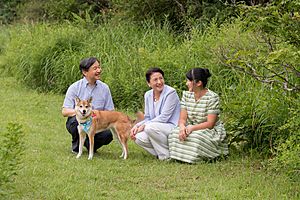
Masako's first pregnancy was announced in December 1999, but she later miscarried.
The Emperor and Empress have one daughter: Aiko, Princess Toshi. She was born on December 1, 2001, in Tokyo.
Aiko's birth, more than eight years after their marriage, started a big discussion in Japan. People debated if the Imperial Household Law should change. This law says that only males can become emperor. Some wanted to change it so a woman could also inherit the throne.
In 2005, a group of experts suggested changing the law. They wanted to allow women to become empress. In 2006, Prime Minister Junichiro Koizumi said he would propose a bill to allow women to ascend the throne.
However, plans to change the law were put on hold. In February 2006, it was announced that Masako's brother-in-law, Prince Akishino, and his wife were expecting their third child. On September 6, 2006, Princess Akishino gave birth to a son, Hisahito. Under the current law, he is third in line to the throne. This means Aiko cannot become empress.
Life as Crown Princess of Japan
As Crown Princess, Masako traveled with her husband to many countries. In 1994, they visited Saudi Arabia, Oman, Qatar, and Bahrain. In 1995, they went to Kuwait, the United Arab Emirates, and Jordan. They returned to Jordan in 1999. Also in 1999, they went to Belgium for a royal wedding. In 2002, they visited New Zealand and Australia. In 2006, they went to the Netherlands with their daughter, Princess Aiko, for a private visit.
On April 30, 2013, the Crown Prince and Crown Princess attended the inauguration of King Willem-Alexander of the Netherlands. This was Masako's first official trip overseas in eleven years. In October 2014, she attended a banquet for King Willem-Alexander and Queen Máxima in Tokyo. This was her first time at such a ceremony in eleven years. In July 2015, Princess Masako traveled to Tonga with the Crown Prince. They attended the Coronation of King Tupou VI. Many Japanese media covered the event, and the Crown Princess was warmly welcomed.
Becoming Empress of Japan
On April 30, 2019, Masako's father-in-law, Emperor Akihito, stepped down from the throne. His eldest son, Crown Prince Naruhito, became the 126th Emperor of Japan. His wife, Masako, became empress consort on May 1. The Emperor and Empress were officially enthroned at the Tokyo Imperial Palace on October 22, 2019.
Naruhito and Masako's first trip abroad as emperor and empress was in September 2022. They went to the United Kingdom for the state funeral of Queen Elizabeth II. In June 2023, they visited Indonesia. This was their first official state visit.
In March 2024, Masako and Naruhito visited Wajima and Suzu. These cities were affected by the Noto earthquake. They also visited an evacuation center in Anamizu in April.
Masako and Naruhito went on a three-day state visit to the United Kingdom in June 2024. They were invited by King Charles III. This trip was originally planned for 2020 but was postponed due to the COVID-19 pandemic. It was the first state visit to happen during an active election campaign in the UK.
Masako's Health
Masako has sometimes been out of the public eye. This was mostly between 2004 and 2014. Reports said it was due to emotional difficulties. These were thought to be caused by the pressure to have a male heir and adjusting to life in the Imperial Family. In July 2004, she was diagnosed with an adjustment disorder.
On July 11, 2008, Naruhito asked the public to understand his wife's health. He was on a trip to Spain without her. He said, "I would like the public to understand that Masako is continuing to make her utmost efforts. Please continue to watch over her kindly and over the long term." The pressure to have a male heir and strict traditions are believed to have contributed to her illness. Also, negative media coverage and the stress of royal duties played a part.
In December 2012, on her 49th birthday, Masako thanked the Japanese people for their support. She said she was still receiving treatment. The Japanese Constitution does not allow Imperial Family members to be involved in politics. Naruhito has spoken about the difficulties his wife faced from the Imperial Household Agency. He also mentioned her wish to continue her diplomatic career.
In 2019, Masako attended official events with her husband. She was also present at his accession ceremonies. During the state visit of U.S. President Donald Trump and First Lady Melania Trump to Japan, Masako and Naruhito spoke with them without interpreters. Both are fluent in English. Her doctors have said she has not fully recovered. However, her strong sense of duty helps her fulfill her responsibilities.
Titles, Styles, and Honours
Titles and Styles
- June 9, 1993 – April 30, 2019: Her Imperial Highness The Crown Princess (皇太子妃殿下 Kōtaishi-hi Denka)
- May 1, 2019 – present: Her Majesty The Empress (皇后陛下 Kōgō Heika)
Honours
Foreign Honours
 Austria: Grand Decoration of Honour in Gold with Sash for Services to the Republic of Austria (1999)
Austria: Grand Decoration of Honour in Gold with Sash for Services to the Republic of Austria (1999) Hungary: Grand Cross of the Order of Merit of the Republic of Hungary (2000)
Hungary: Grand Cross of the Order of Merit of the Republic of Hungary (2000) Malaysia: Honorary Grand Commander of the Order of the Defender of the Realm (2012)
Malaysia: Honorary Grand Commander of the Order of the Defender of the Realm (2012) Netherlands: Grand Cross of the Order of the Crown (October 29, 2014)
Netherlands: Grand Cross of the Order of the Crown (October 29, 2014) Portugal: Grand Cross of the Order of Prince Henry (December 2, 1992)
Portugal: Grand Cross of the Order of Prince Henry (December 2, 1992) Spain: Dame Grand Cross of the Royal Order of Isabella the Catholic (November 8, 2008)
Spain: Dame Grand Cross of the Royal Order of Isabella the Catholic (November 8, 2008) Tonga:
Tonga:
- Grand Cross of the Order of Queen Sālote Tupou III (July 4, 2015)
- Coronation Medal of H.M. King George Tupou V (July 4, 2015)
Honorary Positions
- Honorary President of the Japanese Red Cross Society (formerly vice president as the Crown Princess)
Honorary Degrees
- Doctor of Civil Law, University of Oxford (2024)
See also
 In Spanish: Masako para niños
In Spanish: Masako para niños
- Emperor of Japan: Succession
- Japanese imperial succession debate
- Princess Masako: Prisoner of the Chrysanthemum Throne


